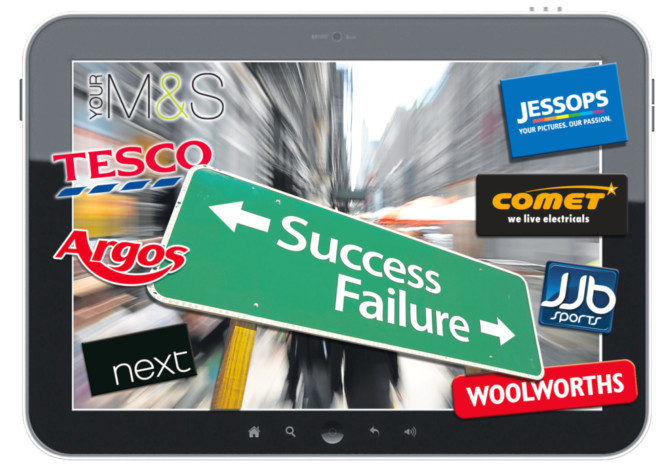Digital or dead. It may seem a stark choice, but it is one the UK High Street is facing as technology-savvy consumers increasingly take their bargain-hunting online.
A number of major retailers this week updated the markets on their Christmas trading figures, and what has become clear is that a major web operation is no longer a luxury, but an essential.
The inexorable rise of web-based shopping is set to continue in 2013, and the phenomenon is already reshaping the UK’s high streets with many high-profile casualties finding themselves unable to compete.
As shoppers tightened their purse strings, more than 50 major retailers went bust last year, including household names such as JJB Sports, Game and Blacks Leisure.
Jessops became the first major victim of 2013, falling into administration just days into the year, putting 2,000 jobs at risk in the process.
In each case, the internet has been noted as a factor in their downfall as they have been unable to cope with competition from more fleet-of-foot rivals unburdened by the costs associated with having a presence on the high street.
The digital revolution was much in evidence over the festive period, with online shopping for food and gifts being a mainstay for many families culminating in a major Boxing Day splurge that saw tens of millions of pounds spent via digital platforms.
Analysts Experian said British consumers spent the equivalent of 14 million hours trawling websites on December 26, paying around 113m visits to online retailers in the process and resulting in web-based sales increasing by 17%, compared to 2011.
Retail’s biggest festive winners all saw an increase in consumer spending online.
Tesco’s biggest ever week for internet sales fell during the festive period, with online food sales up 18%.
House of Fraser saw online sales soar by almost 50% in the six weeks to January 5, while John Lewis a bellweather of the High Street saw internet sales increase by 44% over the 2011 return. The high-end retailer said digital sales now accounted for £1 out of every £4 spent with the store.
Fashion store Next also reported bumper internet-led revenues, which helped take it raise its annual profits projection up to between £611m and £625m.
Conversely, supermarket chain Morrisons said it is now considering the launch of an online grocery store, after it was left behind at Christmas as shoppers abandoned the weekly trek to its stores in favour of home delivery from its rivals.
The grocer said like-for-like sales dropped 2.5% in the six weeks to December 30 likely to be the worst performance from the large supermarket groups.
Major technical and white goods merchant Comet folded out of the retail marketplace late last year, similarly left in the wake of competitors that were faster to grasp the power of online and ‘click and collect’ retail.
Helen Dickinson, director general of the British Retail Consortium, said against the relentlessly tough economic backdrop and low expectations, online was the stand-out retail performer.
She said: “Shoppers are increasingly taking advantage of the convenience that online shopping offers at every stage of the customer journey.”
Her sentiments were echoed in the findings of a Royal Mail survey showing 50% of SME online retailers saw their online sales increase in 2012.
Furthermore, in excess of 66% said they were confident returns from ecommerce would continue to jump throughout 2013.
Marcus Kilby, president of the British Council of Shopping Centres, which represents Britain’s retail property industry, said the shift in consumer attitude meant the High Street had to work harder to draw in customers.
He said shoppers expected to be entertained when out bargain-hunting.
“The consumer, these days, unless they get the right sort of theatre and are made to feel special, will shop online because they have that choice,” Mr Kilby said.
“Retailers have got to put on an increasingly better show to present themselves to the consumer and get people away from their computer screens and into the shops.”
Scottish Retail Consortium’s Mandy Murphy said online retail was a factor in the High Street downturn, but not solely to blame, adding: “It’s important to remember that it’s still a relatively small corner of retail as a whole.
“While we saw very strong online retail sales over Christmas, over the course of a year online sales account for only 10% of total retail sales are made online 90% (of transactions) still take place in stores, of which 43% is on the high streets.”
business@thecourier.co.uk
